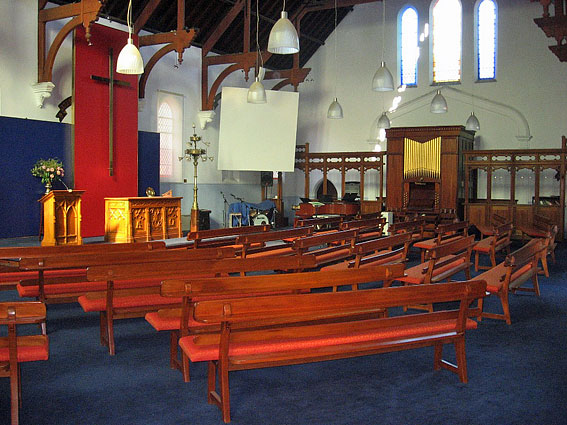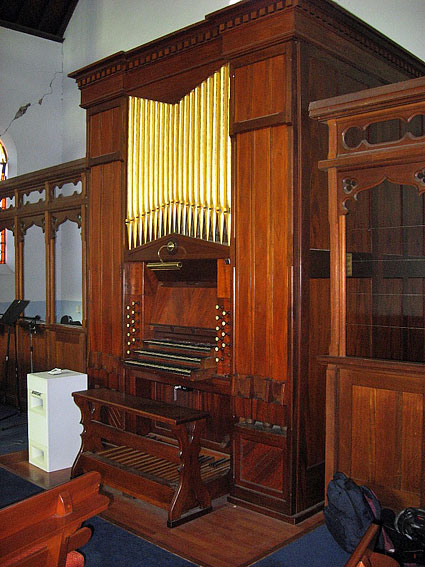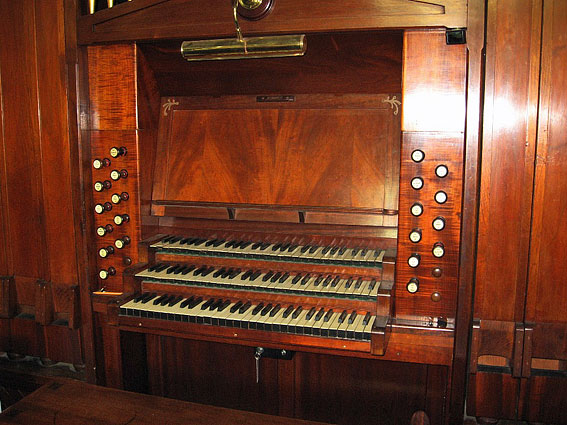St Michael's Anglican Church
McIlwraith Street, North Carlton, Victoria
B. F.W. Slater, Fitzroy [for his residence?];
completed Frederick Taylor; inst present loc 1912.
Res 1996-97 Stewart Organs.
3m, 12spst, 8c, tr. Gt: 8.8.4. Sw: 8.8.4.2.8. Ch: 8.8.4. Ped: 16.


Source: OHTA News, Vol 21, No 4, October 1997, pp 14 - 15
This diminutive three-manual organ was built, according to a church history, by F. W. Slater, of Fitzroy, and was completed by the Hawthorn organbuilder Frederick Taylor before its installation at St Michael's in 1912. The original location of the organ is unknown, although a T.W. Slater was in business as a printer in Nicholson Street nearby, as indicated in contemporary directories. From the style of the case, which incorporated cedar and blackwood panelling, and a prominent dentillated cornice, and the compactness of its construction, it was clearly intended for use in a private residence.
The instrument had received few alterations from the original apart from the removal of the feeders, some case and console panels, the swell Piccolo stop (which could also have been prepared-for), and the extended octaves of other swell stops.
The great and choir organs sit on a common slider chest. The swell has an extended octave at the top to take the octave coupler (shades of the Ingram rebuild of the Melbourne Town Hall organ?), together with vertical shutters on three sides of the box. There is a complex mechanical action, utilising iron rollers and metal squares, including an octave coupler to the swell and a sub octave coupler to the choir. The pedal was originally intended to have an octave coupler also, and the Bourdon chests have an extended octave at the top of the compass. All has been constructed with great skill using excellent materials and components.
The style of the organ totally belies the period of construction and largely eschews the symphonic tendencies which would have been expected at the time. The overall architectural and musical style, including pipework voiced on a very low wind pressure, and a classical case, is reminiscent of an earlier era.
A complete restoration of the instrument has been carried out by Stewart Organs with the assistance of an appeal conducted under the aegis of the National Trust of Australia (Victoria). John Maidment acted as the consultant.
The organ was completely dismantled and moved to a new central position behind the altar (this has since been moved), where it now appears in perfect symmetry. All perishable parts in the action were replaced and the whole reassembled and regulated, a highly time consuming task given the cramped construction of the instrument. The swell soundboard was moved back a short distance to allow improved tuning access and several larger pipes were conveyed to the rear of the swell box to avoid removing pipes to facilitate tuning. Missing case and console panels were replicated in matching materials and the whole carefully repolished. The facade pipes were regilded in gold leaf by Christine Holmes.
Missing console components, including ferrules and stop labels, were replaced in matching materials. A new 2ft stop was made for the swell and new pipework manufactured for the extended octaves.
Possibly the smallest three-manual church organ in the country, the St Michael's instrument was reopened on 10 August 1997. It was also visited during the recent conference and is now an instrument of great charm, and of considerable historic and musical interest.
The specification is as follows*:
| GREAT Open Diapason Stopped Diapason Principal Swell to Great Choir to Great CHOIR Stopped Diapason Dulciana Principal Choir Sub Octave SWELL Open [Violin] Diapason Gedact Principal Fifteenth Clarinet Tremulant Super Octave Choir to Swell PEDAL Bourdon Great to Pedal Swell to Pedal Choir to Pedal |
8 8 4 8 8 4 8 8 4 2 8 16 |
(56 note chest) (grooved bass, Stopped Diapason provides lowest 12 notes; part of tenor C octave in facade) (part of lowest octave in façade) (56 note chest) (unenclosed) (grooved bass, Stopped Diapason provides lowest 12 notes) (Dulcet with slotted bass) (68 note chest) (gvd bass, slotted pipes, Gedact provides lowest 12 notes) (new: replaces missing Piccolo) (42 note chest) (straight, concave pedalboard) (appears there was originally an octave coupler to give 8’ flute) |
compass: 56/30
attached drawknob console
mechanical action throughout
balanced swell pedal (on right)
wind pressure: 55mm
* note that the labels on the stops incorporate 'shorthand' descriptions

Photos: Ken Falconer Sept 2009